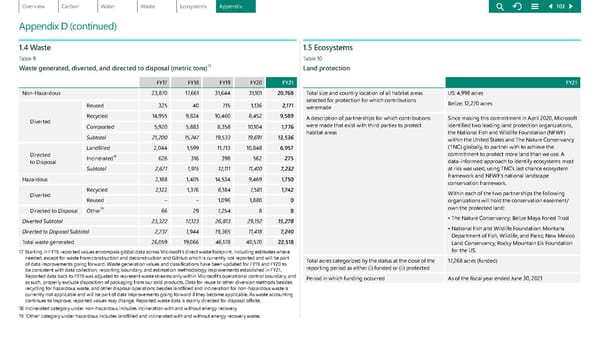Appendix D (continued) 1.4 Waste Table 9 Waste generated, diverted, and directed to disposal (metric tons) 17 FY17 FY18 FY19 FY20 FY21 Non-Hazardous 23,870 17, 6 61 31,644 31,101 20,768 Diverted Reused 325 4 0 715 1,136 2,171 Recycled 14 ,9 55 9,824 10,460 8,452 9,589 Comp osted 5,920 5,883 8,358 10,104 1,776 Subtotal 21,200 15 , 747 19,5 3 3 19,691 13 , 536 Directed to Disp osa l Landfilled 2,044 1,599 11,713 10,8 4 8 6,9 57 I ncinerated 18 626 316 398 562 275 Subtotal 2,67 1 1 ,915 12,111 11,410 7, 232 Haz a rdous 2,188 1, 405 14 ,534 9, 4 69 1,750 Di verted Recy cled 2,122 1,376 6,1 84 7, 5 8 1 1, 74 2 Re u sed – – 1,096 1,88 0 0 Direct ed to Disposal Other 19 66 29 7, 25 4 8 8 Diverted S ubtota l 23,322 1 7,12 3 26, 8 1 3 29,152 15,2 7 8 Directed to D isposal Subtotal 2,737 1,944 19,365 11,418 7, 24 0 Total waste gen e rated 26,059 19,066 46,178 40,570 22,518 17 Starting in FY19, reported values encompass global data across Microsoft's direct waste footprint, including estimates where needed, except for waste from construction and deconstruction and GitHub which is currently not reported and will be part of data improvements going forward. Waste generation values and classifications have been updated for FY19 and FY20 to be consistent with data collection, reporting boundary, and estimation methodology improvements established in FY21. Reported data back to FY19 was adjusted to represent waste streams only within Microsoft’s operational control boundary, and as such, properly exclude disposition of packaging from our sold products. Data for reuse or other diversion methods besides recycling for hazardous waste, and other disposal operations besides landfilled and incineration for non-hazardous waste is currently not applicable and will be part of data improvements going forward if they become applicable. As waste accounting continues to improve, reported values may change. Reported waste data is mainly directed for disposal offsite. 18 Incinerated category under non-hazardous includes incineration with and without energy recovery. 19 'Other' category under hazardous includes landfilled and incinerated with and without energy recovery waste. 1.5 Ecosystems Table 10 Land protection FY21 Total size and country location of all habitat areas selected for protection for which contributions were made US: 4,998 acres Belize: 12,270 acres A description of partnerships for which contributions were made that exist with third parties to protect habitat areas Since making this commitment in April 2020, Microsoft identified two leading land protection organizations, the National Fish and Wildlife Foundation (NFWF) within the United States and The Nature Conservancy (TNC) globally, to partner with to achieve the commitment to protect more land than we use. A data-informed approach to identify ecosystems most at risk was used, using TNC’s last chance ecosystem framework and NFWF’s national landscape conservation framework. Within each of the two partnerships the following organizations will hold the conservation easement/ own the protected land: • The Nature Conservancy: Belize Maya Forest Trust • National Fish and Wildlife Foundation: Montana Department of Fish, Wildlife, and Parks; New Mexico Land Conservancy, Rocky Mountain Elk Foundation for the US. Total acres categorized by the status at the close of the reporting period as either (i) funded or (ii) protected 17,268 acres (funded) Period in which funding occurred As of the fiscal year ended June 30, 2021 103
 Environmental Sustainability Report | Microsoft Page 102 Page 104
Environmental Sustainability Report | Microsoft Page 102 Page 104